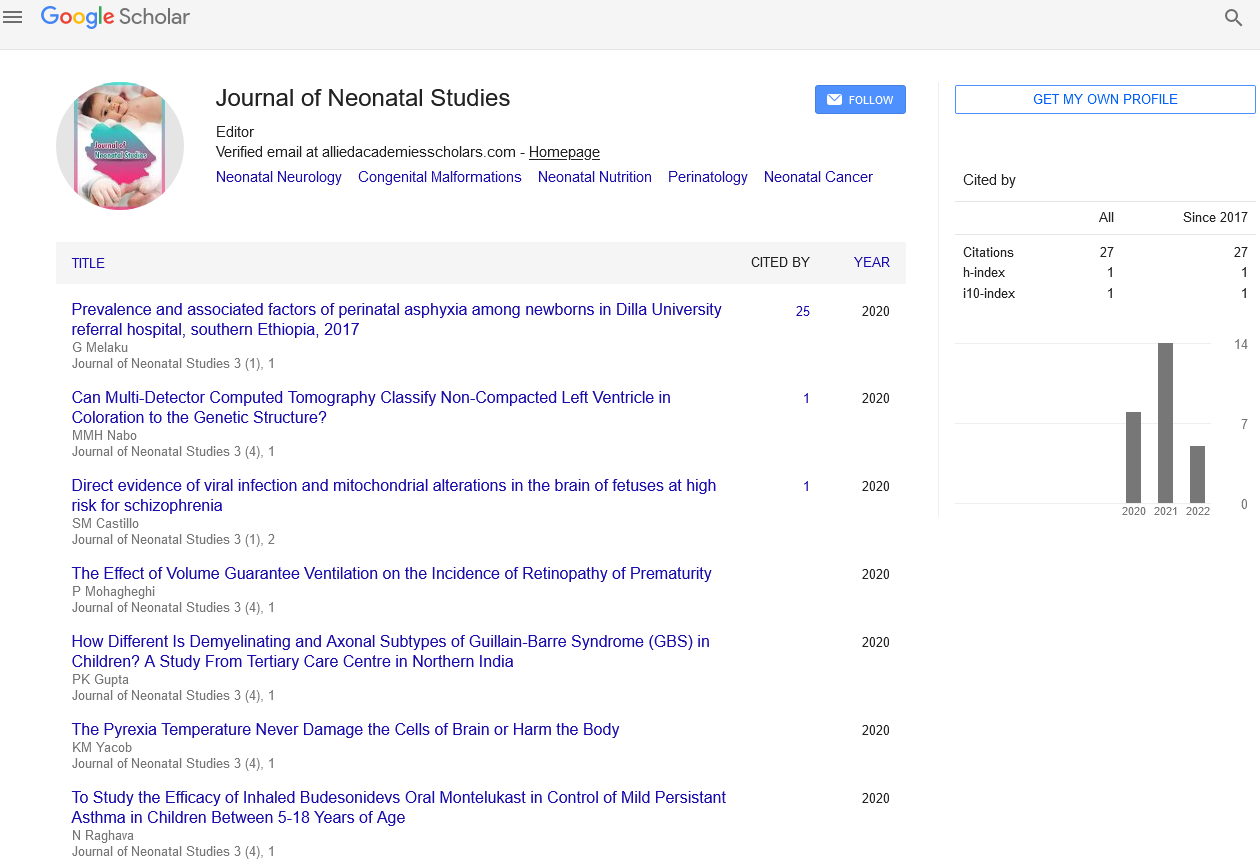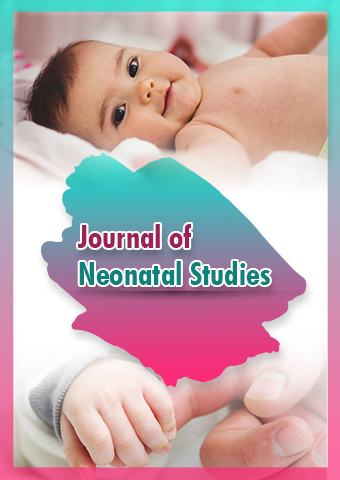Perspective - Journal of Neonatal Studies (2024) Volume 7, Issue 5
Sepsis in Newborns: Understanding, Diagnosis, and Management
- Corresponding Author:
- Nelio Pires
Department of Neonatology, Federal University of Pelotas, Portugal
E-mail: nelio.p@ufpel.edu.br
Received: 02-Sep-2024, Manuscript No. JNS-24-150532; Editor assigned: 04-Sep-2024, PreQC No. JNS-24-150532 (PQ); Reviewed: 18-Sep-2024, QC No. JNS-24-150532; Revised: 23-Oct-2024, Manuscript No. JNS-24-150532 (R); Published: 30-Oct-2024, DOI: 10.37532/JNS.2024.7(5).273-275
Introduction
Sepsis in newborns, also known as neonatal sepsis, is a serious and potentially life-threatening condition. It occurs when a bacterial, viral, or fungal infection spreads throughout the bloodstream, causing systemic inflammation. Sepsis can lead to severe complications, including organ failure and death, if not promptly diagnosed and treated. This article explores the causes, symptoms, diagnosis, treatment, and prevention of sepsis in newborns, highlighting the critical importance of early intervention.
Description
Causes of neonatal sepsis
Neonatal sepsis can be classified into two main categories based on the timing of symptom onset:
Early-Onset Sepsis (EOS): Occurs within the first 72 hours of life. The infection is usually acquired from the mother during pregnancy or delivery. Common causes include:
Group B Streptococcus (GBS): A leading cause of EOS, GBS can be transmitted to the baby during delivery.
Escherichia coli (E. coli): Another common cause, E. coli, can also be transmitted during delivery.
Other pathogens: Less commonly, pathogens such as Listeria monocytogenes and Haemophilus influenzae can cause EOS.
Late-Onset Sepsis (LOS): Occurs after 72 hours of life. The infection is typically acquired from the environment or healthcare setting. Common causes include:
Coagulase-Negative Staphylococci (CoNS): Often associated with indwelling medical devices such as catheters.
Staphylococcus aureus: Including Methicillin-Resistant Staphylococcus aureus (MRSA). Gram-negative bacteria: Such as Klebsiella, Enterobacter, and Pseudomonas. Fungal infections: Particularly in Very Low Birth Weight (VLBW) infants.
Risk factors for neonatal sepsis
Several factors increase the risk of sepsis in newborns:
Prematurity: Preterm infants have underdeveloped immune systems, making them more susceptible to infections.
Low birth weight: Infants weighing less than 2,500 grams at birth are at higher risk.
Maternal infections: Infections in the mother during pregnancy or delivery can be transmitted to the baby.
Prolonged rupture of membranes: Rupture of the amniotic sac for more than 18 hours before delivery increases the risk of infection.
Chorioamnionitis: An infection of the amniotic fluid and membranes surrounding the fetus.
Invasive medical procedures: Use of catheters, mechanical ventilation, or other invasive procedures increases the risk of hospital-acquired infections.
Symptoms of neonatal sepsis
The symptoms of neonatal sepsis can be subtle and non-specific, making early diagnosis challenging. Common signs and symptoms include:
Fever or hypothermia: Elevated or low body temperature.
Lethargy or irritability: Decreased activity or excessive fussiness.
Poor feeding: Refusal to eat or difficulty feeding.
Respiratory distress: Rapid breathing, grunting, or apnea (temporary cessation of breathing).
Jaundice: Yellowing of the skin and eyes.
Vomiting or diarrhea: Gastrointestinal symptoms.
Poor perfusion: Pale or mottled skin, indicating poor blood flow.
Diagnosis of neonatal sepsis
Prompt diagnosis of sepsis is crucial for initiating appropriate treatment. Diagnostic methods include:
Clinical assessment: Observing the infant for signs and symptoms of sepsis and taking a detailed medical history.
Blood tests: Blood cultures are essential for identifying the causative pathogen. Other blood tests, such as Complete Blood Count (CBC), C-Reactive Protein (CRP), and procalcitonin levels, help assess the severity of infection.
Lumbar puncture: A spinal tap may be performed to analyze Cerebrospinal Fluid (CSF) for signs of meningitis.
Urine culture: Used to detect urinary tract infections that may contribute to sepsis.
Imaging studies: Chest X-rays, abdominal ultrasounds, or echocardiograms may be performed to identify potential sources of infection.
Treatment of neonatal sepsis
Early and aggressive treatment is essential for improving outcomes in neonates with sepsis. Treatment strategies include:
Antibiotic therapy: Empiric antibiotic therapy is initiated as soon as sepsis is suspected. The choice of antibiotics is based on the most likely pathogens and local antimicrobial resistance patterns. Commonly used antibiotics include ampicillin, gentamicin, and cefotaxime. Once the causative organism is identified, antibiotic therapy is adjusted accordingly.
Supportive care: Providing supportive care to maintain vital functions and stabilize the infant. This includes intravenous fluids, electrolyte management, and oxygen therapy or mechanical ventilation if needed.
Monitoring and management of complications: Continuous monitoring of the infant’s condition and prompt management of complications such as shock, organ dysfunction, or coagulopathy.
Prevention of neonatal sepsis
Preventing neonatal sepsis involves several strategies aimed at reducing the risk of infection:
Maternal screening and treatment: Screening pregnant women for GBS and other infections during pregnancy and providing appropriate antibiotic prophylaxis during labor to reduce the risk of transmission to the newborn.
Sterile techniques: Strict adherence to sterile techniques during delivery and invasive medical procedures to minimize the risk of hospitalacquired infections.
Hand hygiene: Ensuring proper hand hygiene practices among healthcare providers, parents, and visitors to reduce the spread of infections.
Breastfeeding: Encouraging breastfeeding, as breast milk contains protective antibodies and immune factors that help protect newborns from infections.
Vaccination: Ensuring timely vaccination of infants against vaccine-preventable diseases such as influenza and pneumococcal infections.
Case studies and success stories
Several case studies highlight the importance of early diagnosis, prompt treatment, and preventive measures in managing neonatal sepsis:
Case study 1: A preterm infant born at 30 weeks’ gestation developed signs of respiratory distress and poor feeding within the first 48 hours of life. Blood cultures confirmed the presence of GBS. The infant received empiric antibiotic therapy with ampicillin and gentamicin, followed by targeted antibiotic therapy based on culture results. With prompt treatment and supportive care, the infant recovered fully and was discharged from the NICU in good health.
Case study 2: A full-term infant presented with fever, irritability, and poor feeding at 10 days of age. Blood cultures and a lumbar puncture revealed E. coli meningitis. The infant was treated with intravenous cefotaxime and supportive care. Early intervention and appropriate antibiotic therapy resulted in a positive outcome, with no long-term neurological sequelae.
Case study 3: An infant born to a mother with chorioamnionitis was monitored closely for signs of sepsis. Prophylactic antibiotics were administered, and the infant remained stable with no signs of infection. The preventive measures taken by the healthcare team helped ensure the infant’s well-being.
Research and future directions
Ongoing research aims to improve the understanding, diagnosis, and treatment of neonatal sepsis. Some areas of focus include:
Biomarkers: Identifying and validating new biomarkers for early and accurate diagnosis of sepsis in newborns.
Antimicrobial stewardship: Developing strategies to optimize antibiotic use and reduce the risk of antimicrobial resistance.
Immunotherapy: Exploring the potential of immunotherapy to enhance the newborn’s immune response to infections.
Global health initiatives: Implementing effective sepsis prevention and treatment protocols in low-resource settings to reduce the global burden of neonatal sepsis.
Conclusion
Neonatal sepsis is a life-threatening condition that requires prompt diagnosis and aggressive treatment to improve outcomes. Understanding the causes, risk factors, symptoms, and management strategies is essential for healthcare providers, parents, and caregivers. Preventive measures, such as maternal screening, sterile techniques, and hand hygiene, play a crucial role in reducing the risk of sepsis in newborns. Ongoing research and advancements in neonatal care continue to enhance our ability to diagnose, treat, and prevent this serious condition, ultimately improving the health and well-being of infants worldwide.

